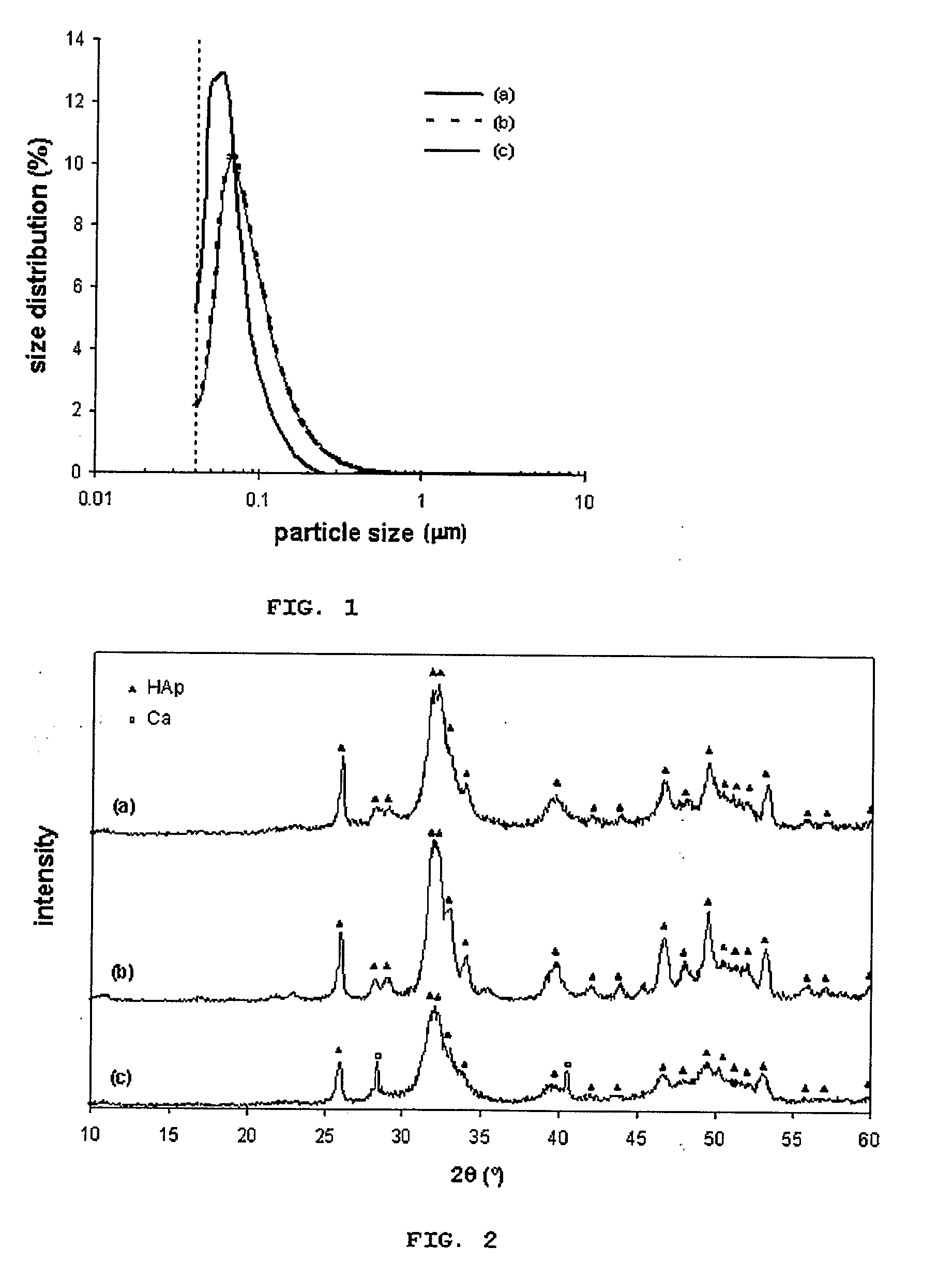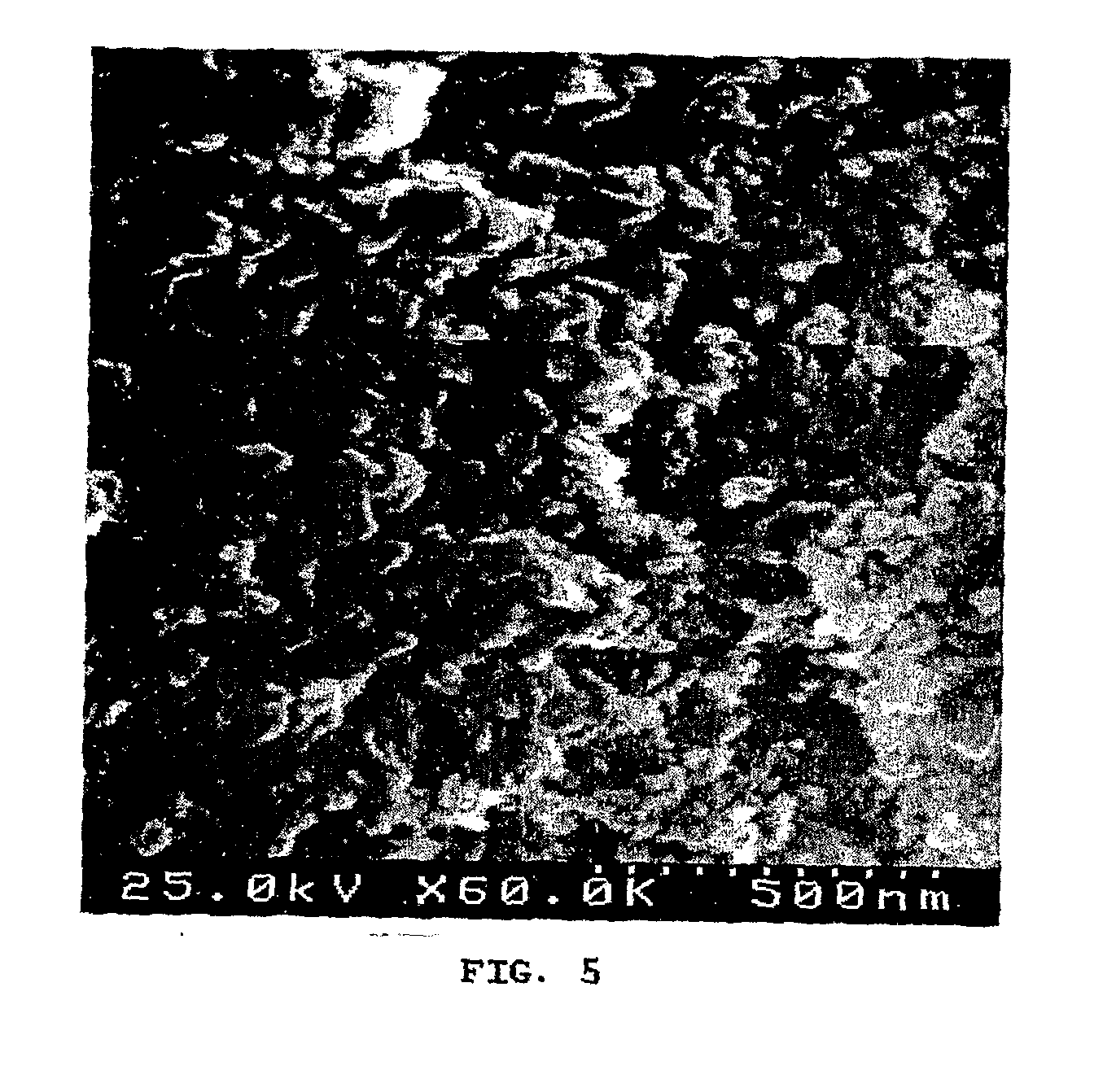Production method for calcium phosphate nano-particles with high purity and their use
a calcium phosphate nano-particle and production method technology, applied in biocide, inorganic chemistry, pharmaceutical non-active ingredients, etc., can solve the problems of stagnation zone formation, short-cuts that are hardly overcame, stirred reactors cannot ensure good micromixing quality, etc., to improve mixing efficiency, improve the effect of quality and cost of the final produ
- Summary
- Abstract
- Description
- Claims
- Application Information
AI Technical Summary
Benefits of technology
Problems solved by technology
Method used
Image
Examples
application examples
Example 1
Needle-Like Shaped Hydroxyapatite Nanoparticles Production.
[0054]Production of hydroxyapatite n anoparticles at 25° C. was performed in the commercial NETmix® reactor with 15 inlet ports to feed the reactants solutions and 15 outlets for product recovery. Preparation of 0.5M Ca(NO3)2×4H2O solution, 0.3M NH4H2PO4 solution and 14 solutions of NUOH with different pH values (between 8 and 14). The calcium and phosphorous solutions were fed in one single reactor point (inlet 1). The ammonia solutions were fed on the inlets 2 to 15, with increasing pH order from port 2 to port 15. The hydroxyapatite suspension produced was analysed to determine the particle size distribution curve (FIG. 1.a), where the average particles diameter was dp=63 nm. Due to equipment limitations, it was not possible to obtain size distribution ranges lower than 40 nm. Therefore, the real average particle diameter is lower than the referred value (dp2.a) proving that the as prepared sample is fairly cryst...
example 2
Spherical Shaped Hydroxyapatite Nanoparticles Production.
[0055]Production of hydroxyapatite n anoparticles at 25° C. was performed in the commercial NETmix® reactor with 15 inlet ports to feed the reactants solutions and 15 outlets for product recovery. Preparation of a Ca(NO3)2×4H2O solution with pH adjusted to 11 by addition of a KOH solution and a NH4H2PO4 solution with pH adjusted to 12 by addition of a KOH solution. Calcium and phosphorous solutions were alternatively fed at the reactor's inlet: odd inlets were used for calcium solution and even inlets for phosphorous solution, guarantying global stoichiometry (Ca / P molar ratio) in any part of the reactor as 10:6. The produced hydroxyapatite suspension was analysed to determine the particle size distribution curve (FIG. 1.b), and the average particles diameter was of dp=82 nm. Due to equipment limitations described before, the real average particle diameter is lower than this value. The hydroxyapatite powder was analysed by XRD...
example 3
[0056]Spherical Shaped Hydroxyapatite Nano Particles Production with Low Crystallinity.
[0057]Production of hydroxyapatite n anoparticles at 25° C. was performed in the commercial NETmix® reactor with 15 inlet ports to feed the reactants solutions and 15 outlets for product recovery. Preparation of a CaCl2 aqueous solution containing 20% in volume of ethanol and pH=11 (by adding a KOH solution) and KH2PO4 aqueous solution containing 20% in volume of ethanol and pH=12 (by adding a KOH solution). The calcium and phosphorous solutions were fed alternatively at the reactor's inlet: odd inlets were used for calcium solutions and even inlets for phosphorous solution, guarantying the global stoichiometry (Ca / P molar ratio) in any part of the reactor as 10:6. FIG. 1.c shows that hydroxyapatite particles size distribution curve is very similar to one of example 2. However, this sample has lower crystallinity than the previous one, as it can be confirmed by the XRD analysis (FIG. 2.c). The SEM...
PUM
| Property | Measurement | Unit |
|---|---|---|
| purity | aaaaa | aaaaa |
| concentrations | aaaaa | aaaaa |
| temperature | aaaaa | aaaaa |
Abstract
Description
Claims
Application Information
 Login to View More
Login to View More - R&D
- Intellectual Property
- Life Sciences
- Materials
- Tech Scout
- Unparalleled Data Quality
- Higher Quality Content
- 60% Fewer Hallucinations
Browse by: Latest US Patents, China's latest patents, Technical Efficacy Thesaurus, Application Domain, Technology Topic, Popular Technical Reports.
© 2025 PatSnap. All rights reserved.Legal|Privacy policy|Modern Slavery Act Transparency Statement|Sitemap|About US| Contact US: help@patsnap.com



